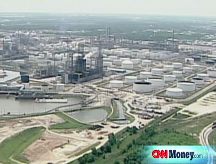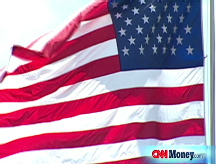Oil settles above $67
Weak dollar and global market rebound help lift oil prices, offsetting government supply report and Fed rate cut.
NEW YORK (CNNMoney.com) -- The price of oil rose Wednesday as the dollar retreated from recent highs and signs of strength in overseas markets tempered some concerns about waning demand.
A widely expected interest rate cut by the Federal Reserve had little impact on oil prices as investors appeared to have priced in the central bank's latest attempt at boosting the economy.
Light, sweet crude for November delivery rose $4.77 to settle at $67.50 a barrel on the New York Mercantile Exchange. Earlier in the session, oil rose more than $6 to trade at $68.91 a barrel.
On Tuesday, the price oil settled at $62.73 a barrel, its lowest level in 17 months.
The gains come despite the government's weekly inventory report, which showed a smaller-than-expected build in the nation's supply of crude oil and a sharp drop in gasoline stocks.
Wednesday's inventory numbers "were certainly not bullish," said Steve Schork, energy analyst and publisher of the industry newsletter The Schork Report. But the supply report "is not enough to trump the weakness in the dollar, which is the primary driver today," he added.
The dollar was pushed lower against other currencies as gains in Asian and European markets boosted confidence and increased demand for higher-yielding currencies.
A less robust dollar makes crude and other commodities that are priced in dollars more appealing to overseas buyers. And many investors buy oil when the dollar weakens to hedge against inflation.
The dollar fell further after the Federal Reserve announced it would cut a key interbank lending rate by a half-percentage point to 1%.
Stocks in the Untied States were volatile after the Fed announced its decision as investors weighed lower interest rates against the central bank's grim assessment of the economy.
At the same time, an overnight rally in Asian and European markets helped foster a belief in the oil market that economic weakness may not crimp demand as much as expected.
Concern about falling demand in a slow economy has driven the price of oil down 57% since it peaked near $150 a barrel in mid-July. But many analysts are now expressing concern that the dramatic slide in oil prices may result in a future price shock when demand for energy eventually returns.
"Supply is really suffering," said Ray Carbone, president of New York-based commodities trading firm Paramount Options.
"When demand comes back, we're not going to have enough to meet demand." Carbone said. "And that could propel prices even higher than they were in July."
Government data: In its weekly inventory report, the Energy Information Administration said the nation's supplies of crude oil rose 500,000 barrels in the week ended Oct. 24.
Analysts were expecting a gain of 1.5 million barrels, according to a survey by energy research firm Platts.
However, a build of 500,000 barrels is within the normal range for crude supplies at this time of year, according to Schork.
The oil industry is entering the "fall turnaround" when refiners go offline to do maintenance and prepare for the winter fuels season, he added.
Supplies of gasoline fell 1.5 million barrels, and supplies of distillates - used to make heating oil and jet fuel - rose by 2.3 million barrels last week.
Gas stocks were expected to rise 900,000 barrels, while distillates were forecast to rise 1 million barrels.
Given the recent decline in gasoline prices, refiners "have no economic incentive to make gas," Schork said. However, as the winter heating season begins, "the profit motive is in the manufacture of distillate production," he added.
Retail gas: Prices at the pump fell for the 42nd-straight day to levels not seen since March 2007.
The national average price for a gallon of regular gas fell another 4 cents overnight to $2.589, according to a daily survey by the American Automobile Association.
Prices are now down 37.1%, or $1.485, from the record high price of $4.114 a gallon set on July 17.
Even with falling prices, demand for gas continues to drop.
The EIA report showed that demand for gas has averaged 8.9 million barrels per day over the last four weeks. That's down by 3.4% from the same period last year.
Separately, a recent Department of Energy report showed that Americans are driving 5.6% less than last year. And a weekly MasterCard survey of gas purchases showed motorists consumed 6.4% less gas in the past week compared to a year ago. ![]()



